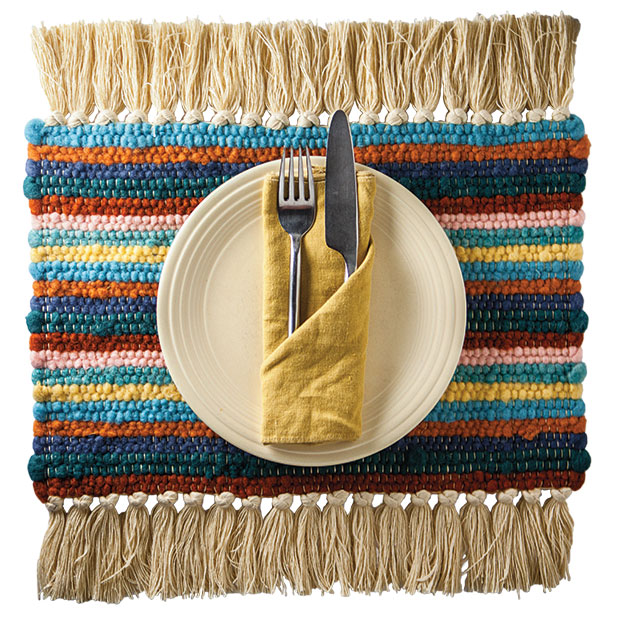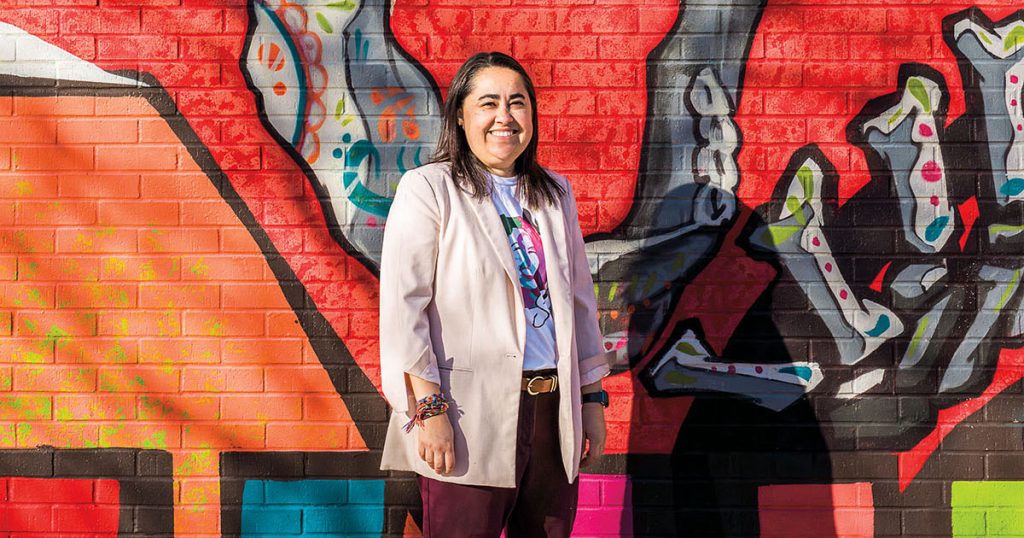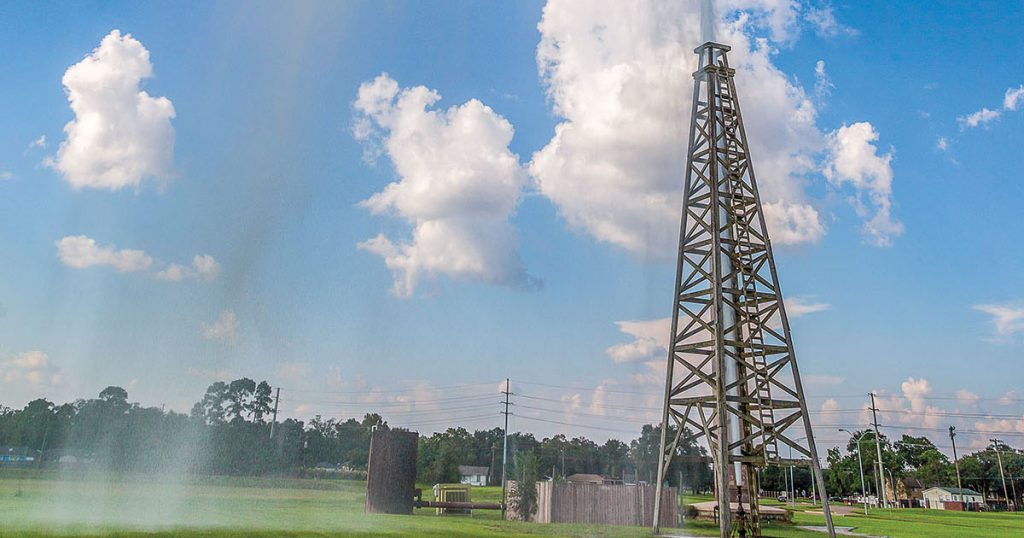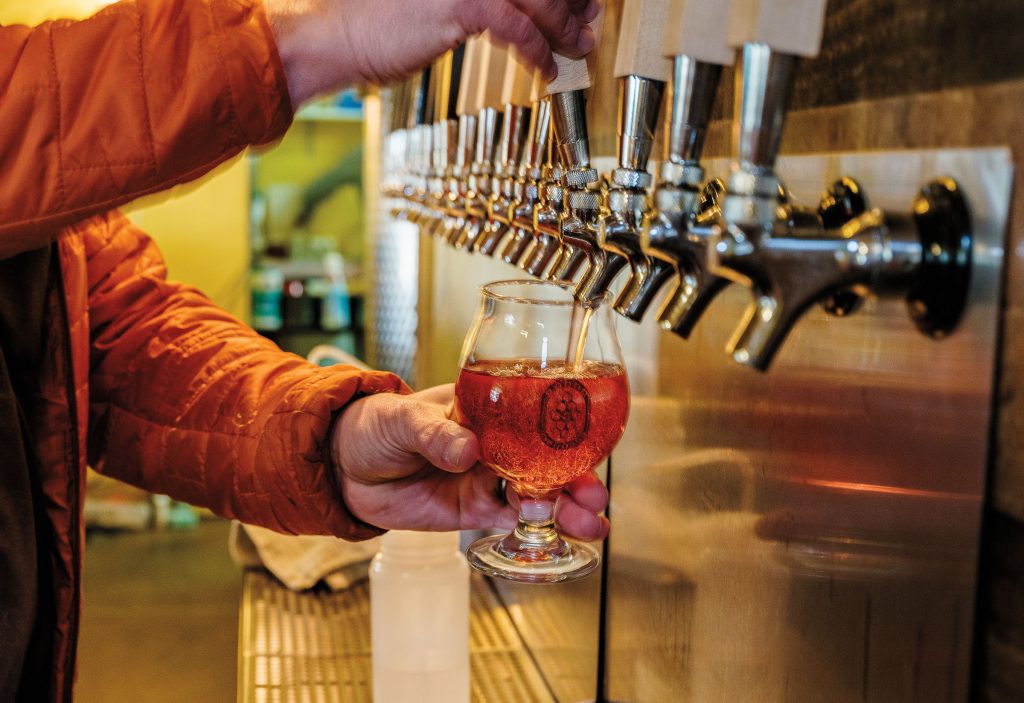
A small bell tinkles as I push open the door and enter the store, worn wooden floorboards creaking beneath my feet. A tall ceiling soars overhead, and dust motes dance in the light streaming through large windows as I walk between stacks of rugs. I flip through the variety of patterns and muted shades, then run my fingers across several thick, colorful saddle blankets draped across a rack. On a shelf nearby, a pile of brightly striped placemats ($15-$30) catches my eye, and I know I’ve found my Paint Rock souvenir.
Ingrid’s Custom Hand-Woven Rugs is at 141 S. Roberts (US 83) in Paint Rock. With advance notice, you can tour the factory and watch employees spin, weave, and finish items. Call 325/732-4370. To arrange to see the rock art, call 325/732-4376.
This tiny town, about 30 miles due east of San Angelo, owes its name to an impressive collection of rock pictographs on a bluff near the Concho River. Early artists created pictographs by applying minerals and dyes to rock, most commonly with their fingers but sometimes with brushes made of animal or plant fiber.
Tours of these paintings, located on the private Campbell Ranch, are one of the area’s main tourist attractions and the reason for my visit. At my appointed time (reservations are a must), Kay Campbell meets me in the visitor center, where stacks of photos and drawings and chunks of rock cover several tables. Campbell grew up on this land, which her grandfather D.E. Sims purchased in 1870, primarily because he wanted to preserve the rock art. She explains that the paintings span thousands of years and multiple native peoples. While we can (and do) speculate what they mean, no one knows for sure. Then we hop in her car and drive down to the bluff.
About 70 feet high and several hundred yards long, this bluff of limestone boulders and cacti contains more than 1,000 images. I easily pick out geometric designs, along with images that look like canoes, stick figures, and hands, some of the latter reminding me of the palm outlines my children once brought home from school. With Campbell’s guidance, I also see an hourglass, what looks like an old Spanish-style church, a stalk of corn, a bison, a roadrunner, and a bird that could be a turkey. Tally marks line one surface, as if ancient visitors kept track of time spent here. Some paintings have faded, but others, protected by overhangs of rock, remain clear. I want to hug Campbell and thank her and her family for keeping them safe.
Back at the visitor center, I admire a rug on the floor and am thrilled when Campbell says it was made right here in Paint Rock. The shop, she tells me, is catty-corner from Paint Rock’s circa-1886 courthouse, a two-story stone structure topped with a red roof. Sure enough, when I drive back to the town, I notice the sign: “Ingrid’s Hand-Woven Rugs.”
Native Austrian Reinhard Schoffthaler bought this shop in 1981 from his cousins Ingrid and Leo Haas, who started the operation in 1979. Schooled in Austria as a chef, Schoffthaler came to the United States in 1969 to learn English. He opened a restaurant in New York, but quickly discovered that that career wasn’t compatible with raising his daughter. So, when the shop became available, he decided to move to Texas.
Ingrid and Leo stayed on for two years, teaching their cousin the business. At the time, the shop ran five looms; since then, a local craftsman has built eight more.
At first, weavers worked exclusive-ly with sheep wool and goat mohair, most of it from nearby ranches. Concho County once ranked as the nation’s leading sheep-producing county, and many people in the area still raise sheep for wool and Angora goats for hair. But, Schoffthaler says, those fibers have a soft texture, and coarse fiber makes better rugs. He began ordering coarse fiber from New Zealand, and then about 10 years ago, he received a call from Dan and Dale Goodyear, who raise alpacas in Pennsylvania. “They heard about us from the Texas Tech University International Textile Center, where we used to have our fiber dyed,” Schoffthaler recalls. The Goodyears sent a few pounds of their alpaca fiber to the Paint Rock shop, and the weavers succeeded in working with it and sent the resulting textiles back to the Goodyears to sell. “Then it snowballed, because people raising alpacas all know each other and they spread the word,” says Schoffthaler.
As a result, the shop now works with fiber from across the country and Canada, including about 30 suppliers in Texas, creating rugs and other items from goat, alpaca, llama, yak, and even bison hair.
Concho County once ranked as the nation’s leading sheep-producing county, and many people in the area still raise sheep for wool and Angora goats for hair.
Alpaca remains Schoffthaler’s favorite. “It’s a great fiber,” he says. “A pair of alpaca socks is very warm and causes no allergies because there is no lanolin. For rugs, we use a coarser grade that is very sturdy.” For saddle blankets, the weavers use slightly thicker wool, which makes the pads very durable, and very popular. “People always reorder our horse blankets,” he says.
Fiber arrives at the shop in raw form—looking as if it just came off of its original owner, albeit perhaps a bit cleaner—and is corded and spun around a jute core. That makes it durable and reversible. It takes roughly 20 pounds of fiber to produce a six-by-nine-foot rug.
These days, the shop makes the rugs, and its 1,600 or so fiber suppliers sell them. (Schoffthaler is happy to share contact numbers.) Current orders will keep the Paint Rock looms busy for the next three to four months. As a result, Schoffthaler does no marketing and keeps only a small inventory at the store, which opens Monday through Friday from 8 a.m. to 4:30 p.m. While you can still walk in and order a custom rug, he says, you’ll have to wait awhile to receive it.
The looms can produce a rug up to 12 feet wide and any length. Saddle blankets and placemats are created in the same manner as the rugs and on the same looms, only on a smaller scale, of course.
Back home, my colorful striped placemats brighten my table, reminding me at every meal of a quiet Texas town, a cliff covered in mysterious images, and a family dedicated to preserving them.








